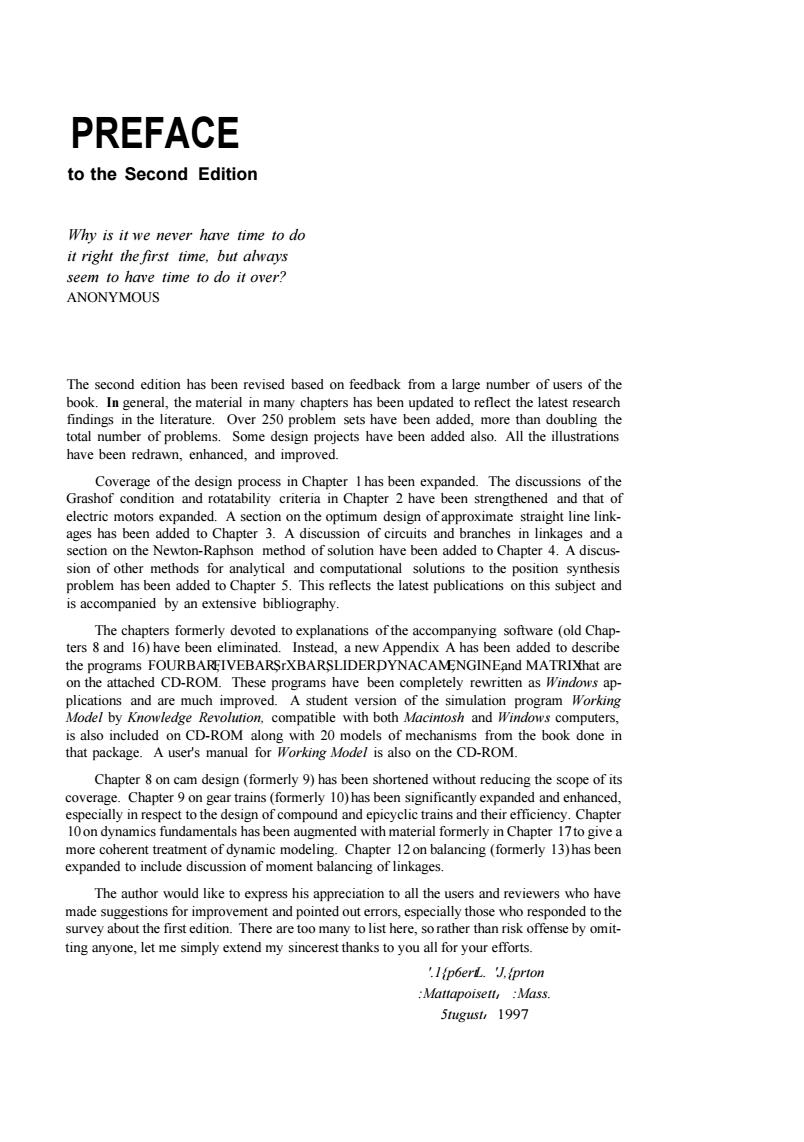正在加载图片...

PREFACE to the Second Edition Why is it we never have time to do it right the first time,but always seem to have time to do it over? ANONYMOUS The second edition has been revised based on feedback from a large number of users of the book.In general,the material in many chapters has been updated to reflect the latest research findings in the literature.Over 250 problem sets have been added,more than doubling the total number of problems.Some design projects have been added also.All the illustrations have been redrawn,enhanced,and improved. Coverage of the design process in Chapter I has been expanded.The discussions of the Grashof condition and rotatability criteria in Chapter 2 have been strengthened and that of electric motors expanded.A section on the optimum design of approximate straight line link- ages has been added to Chapter 3.A discussion of circuits and branches in linkages and a section on the Newton-Raphson method of solution have been added to Chapter 4.A discus- sion of other methods for analytical and computational solutions to the position synthesis problem has been added to Chapter 5.This reflects the latest publications on this subject and is accompanied by an extensive bibliography. The chapters formerly devoted to explanations of the accompanying software (old Chap- ters 8 and 16)have been eliminated.Instead,a new Appendix A has been added to describe the programs FOURBAREIVEBARSrXBARSLIDERDYNACAMENGINEand MATRIXthat are on the attached CD-ROM.These programs have been completely rewritten as Windows ap- plications and are much improved.A student version of the simulation program Working Model by Knowledge Revolution,compatible with both Macintosh and Windows computers, is also included on CD-ROM along with 20 models of mechanisms from the book done in that package.A user's manual for Working Model is also on the CD-ROM. Chapter 8 on cam design(formerly 9)has been shortened without reducing the scope of its coverage.Chapter 9 on gear trains(formerly 10)has been significantly expanded and enhanced, especially in respect to the design of compound and epicyclic trains and their efficiency.Chapter 10on dynamics fundamentals has been augmented with material formerly in Chapter 17to give a more coherent treatment of dynamic modeling.Chapter 12 on balancing (formerly 13)has been expanded to include discussion of moment balancing of linkages. The author would like to express his appreciation to all the users and reviewers who have made suggestions for improvement and pointed out errors,especially those who responded to the survey about the first edition.There are too many to list here,so rather than risk offense by omit- ting anyone,let me simply extend my sincerest thanks to you all for your efforts. '.1(p6erd.J.(prton :Mattapoisett,:Mass. 5tugustr 1997PREFACE to the Second Edition Why is it we never have time to do it right the first time, but always seem to have time to do it over? ANONYMOUS The second edition has been revised based on feedback from a large number of users of the book. In general, the material in many chapters has been updated to reflect the latest research findings in the literature. Over 250 problem sets have been added, more than doubling the total number of problems. Some design projects have been added also. All the illustrations have been redrawn, enhanced, and improved. Coverage of the design process in Chapter 1 has been expanded. The discussions of the Grashof condition and rotatability criteria in Chapter 2 have been strengthened and that of electric motors expanded. A section on the optimum design of approximate straight line linkages has been added to Chapter 3. A discussion of circuits and branches in linkages and a section on the Newton-Raphson method of solution have been added to Chapter 4. A discussion of other methods for analytical and computational solutions to the position synthesis problem has been added to Chapter 5. This reflects the latest publications on this subject and is accompanied by an extensive bibliography. The chapters formerly devoted to explanations of the accompanying software (old Chapters 8 and 16) have been eliminated. Instead, a new Appendix A has been added to describe the programs FOURBAR,FIVEBAR,SrXBAR,SLIDER,DYNACAM,ENGINE,and MATRIXthat are on the attached CD-ROM. These programs have been completely rewritten as Windows applications and are much improved. A student version of the simulation program Working Model by Knowledge Revolution, compatible with both Macintosh and Windows computers, is also included on CD-ROM along with 20 models of mechanisms from the book done in that package. A user's manual for Working Model is also on the CD-ROM. Chapter 8 on cam design (formerly 9) has been shortened without reducing the scope of its coverage. Chapter 9 on gear trains (formerly 10) has been significantly expanded and enhanced, especially in respect to the design of compound and epicyclic trains and their efficiency. Chapter 10on dynamics fundamentals has been augmented with material formerly in Chapter 17to give a more coherent treatment of dynamic modeling. Chapter 12 on balancing (formerly 13) has been expanded to include discussion of moment balancing of linkages. The author would like to express his appreciation to all the users and reviewers who have made suggestions for improvement and pointed out errors, especially those who responded to the survey about the first edition. There are too many to list here, so rather than risk offense by omitting anyone, let me simply extend my sincerest thanks to you all for your efforts. '.1{p6ertL. 'J,{prton :Mattapoisettl :Mass. 5tugustl 1997